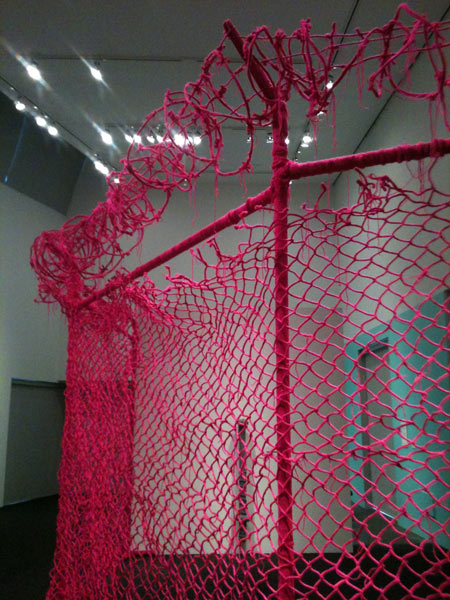
From hot-pink razor wire to shimmery translucent water bottles to puffs of cancerous looking growths, softness has never looked so sinister. ”The Mysterious Content of Softness,” featuring both local and internationally known artists working in fiber, is striking for its lack of delicacy.
These sculptural pieces are carefully constructed of materials traditionally associated with the decorative intent of craft — predominantly yarn, thread, and fabric — yet this exhibit displays a strong political bent, addressing prescribed gender roles and the environmental impact of objects rendered in material more permanent that fabric.
Entering the upstairs gallery, a hot pink chain link fence is the first thing you see, Lacey Jane Roberts’s “We Couldn't Get In, We Couldn't Get Out.” The artist hand-made the ten foot tall fence, bending the wire and encasing each segment in knit tubes of Barbie-pink yarn, which she produced using a 1974 Barbie-brand toy knitting machine. This work divides the gallery so that viewers are either inside our outside of the fence; a body has to take sides. The structure is both garish and gorgeous, a fence in drag. Its pinkness offers a hard-to-miss critique of the way that gender roles are socially drawn as restrictive, even inescapable. This piece is over-the-top too much, and yet, its form is true to life. There is steel encased within soft yarn, and there is no razor wire inside the looping circles atop the artist’s chain-link contraption. But the visual menace is there.
Further explorations of body politics are around the corner, where Nathan Vincent’s “Locker Room” is installed. The hard edges of a men’s locker room — lockers, a wooden bench, urinals, and an open shower — are rendered in foam-stuffed knit fixtures. It’s a highly accurate installation and also unmistakably comical, but it mostly conveys a feeling of vulnerability. There is no privacy: the lockers are not high enough to hide behind, the gallery wall has been painted a clinical blue. The shower has no curtain. The urinals have no dividers. The gallery itself exposes this locker room, without so much as a door to pretend privacy. A locker room is a public venue to undress, and it’s a place where one’s body issues are revealed. One changes out of one’s street clothes and into a gym uniform, and showers in close proximity to strangers. Here, the men’s locker room is not a realm of proud masculinity, but a place where insecurity renders even the furniture soft.
There are many more strong works in this exhibit, most of which explore issues of body and identity. Diem Chau’s silk embroidered portraits depict single women with long black braids. The artist couple Miller & Shellabarger knitted “Pink Tube,” a length of yarn which both connects and divides them. There’s a puffy, sagging, floor-to-ceiling installation by Lisa Kellner that looks like a growth of anemones or bloody, diseased cells. You can just feel the inevitable decline of the body.
The most striking works here are Lauren DiCioccio’s deconstructed still lifes, which depict plastic water bottles, old “National Geographic” magazines, and phone books in translucent organza. Her life-sized objects are deflated and messy, with loose threads, sloppy text, and a sense of impermanence. The objects she renders are all-too-common trash, whose originals will likely outlast those of us looking at this work. These are the delicate bodies she compels us to look at: our own mortal selves, as well as the body of art.
